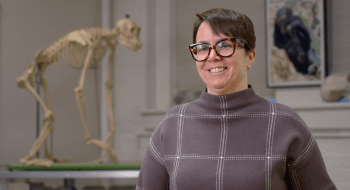
Everything You Need to Know About Viewing the Total Solar Eclipse
With an astronomical moment like this, it's no surprise that there is a lot of information to keep track of. In this story, we share answers to your burning total solar eclipse questions like: When will the eclipse take place? Where can I get the best view? How can I safely view the total eclipse?
The Basics: What, When, Where
What
A total solar eclipse is the very rare result of the Moon passing between the Sun and Earth, at just the right spot in its orbit to completely block the Sun and cast a shadow on Earth. According to NASA, “It is the result of a cosmic coincidence.” Even though the Sun is about 400 times bigger than the Moon, it is also about 400 times farther away. This makes the Sun and the Moon appear almost exactly the same size in our sky.
When
The total solar eclipse is Monday, April 8 and will darken the skies over Canton, New York from approximately 3:23-3:27 p.m.
Where
According to NASA, the first location in continental North America that will experience totality is Mexico’s Pacific Coast at around 11:07 a.m. Pacific Daylight Time (2:07 p.m. in New York). The path of the eclipse enters the United States in Texas, and travels through Oklahoma, Arkansas, Missouri, Illinois, Kentucky, Indiana, Ohio, Pennsylvania, New York, Vermont, New Hampshire, and Maine. Small parts of Tennessee and Michigan will also experience the total solar eclipse. The eclipse will enter Canada in Southern Ontario and will exit continental North America on the Atlantic coast of Newfoundland, Canada, at 5:16 p.m. Newfoundland Daylight Time (which is 3:46 p.m. in New York).
Not sure where your location lies in relation to the path of totality? View our resources here.
Safety First
According to NASA, viewing any part of the Sun through a camera lens, binoculars, or a telescope without a special-purpose solar filter will instantly cause severe eye injury. Eclipse viewing glasses are strongly recommended during the partial eclipse phases before and after totality. These specially designed glasses are equipped with a solar filter that reduces the Sun’s intensity to safe levels for your eyes.
A key indicator of safe eyewear is if they are labeled: ISO 12312-2. You can also spot a good pair of eye protection if they appear to have a darker lens than a typical pair of sunglasses.
See the Sun Without Glasses
The corona, or crown, is the outer ring of the Sun’s atmosphere consisting of hot ionized gas that is blown off the Sun. That material glows because it’s almost 1 million degrees. It’s always there, but we can rarely see it because it is obscured by the bright disk of the Sun, O’Donoghue says.
However, once the Sun is completely covered by the Moon, explains astronomy instructor Jeff Miller, it’s safe to remove your glasses in order to glimpse the glowing white corona. (You’ll know it’s safe when you can no longer see any part of the Sun through eclipse glasses or a solar viewer.) “But remember: we’ve got to put the glasses back on before the Moon slides away and lets the light through, or else you risk damage to your eyes” Miller adds.
Total Solar Eclipse Info

We've gathered all of our resources and expert insights to create your very own total solar eclipse information hub. Stay up to date on what you can expect on April 8, read stories from our community, and even commemorate the out-of-this-world event with custom St. Lawrence merchandise.



